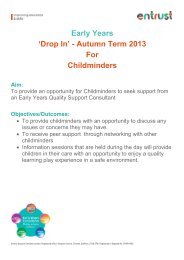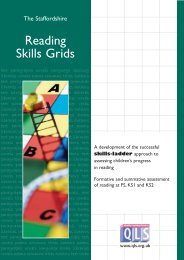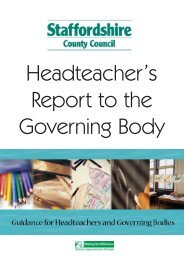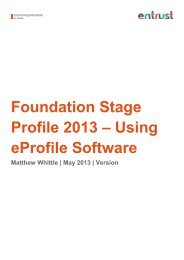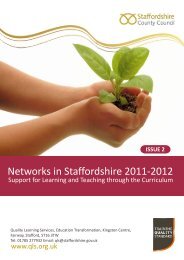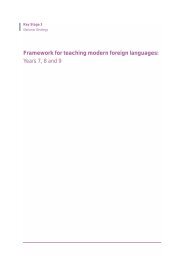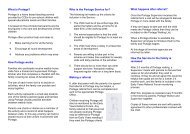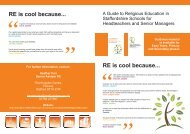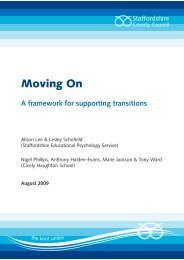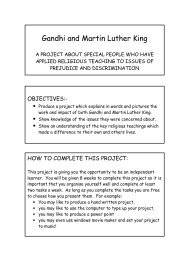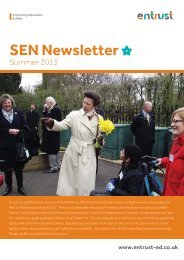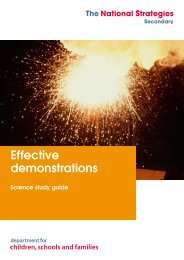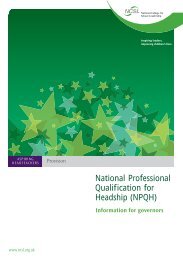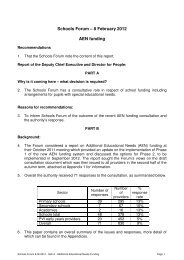KS2 Framework for Languages - Staffordshire Learning Net
KS2 Framework for Languages - Staffordshire Learning Net
KS2 Framework for Languages - Staffordshire Learning Net
Create successful ePaper yourself
Turn your PDF publications into a flip-book with our unique Google optimized e-Paper software.
The <strong>Framework</strong> as a Point of Reference<br />
The <strong>Framework</strong> is available on-line at www.standards.dfes.gov.uk/primary/languages and<br />
in hard copy, and it is supplemented by two sets of support materials.<br />
Part 1 – the <strong>Framework</strong> itself sets out:<br />
• <strong>Learning</strong> objectives which show progression over the four years of Key Stage 2 in<br />
Oracy, Literacy and Intercultural Understanding<br />
• Two ‘cross-cutting’ strands showing how Knowledge about Language (KAL) and<br />
Language <strong>Learning</strong> Strategies (LLS) relate to these objectives<br />
• Sample teaching activities.<br />
Part 2 provides more targeted advice <strong>for</strong> different users of the <strong>Framework</strong> – those who are<br />
introducing primary languages from scratch, those who have experience of teaching primary<br />
languages, those with responsibility <strong>for</strong> managing and co-ordinating the curriculum and those<br />
working in Key Stage 3 who will be supporting primary language learning and transition.<br />
Part 3 of the framework documentation – Planning <strong>for</strong> Entitlement will be available to schools<br />
from the spring term of 2005/2006. A comprehensive range of materials offers detailed<br />
guidance on whole-school planning to teachers and head teachers as they introduce<br />
languages into the primary curriculum. The materials include planning tools and detailed<br />
explanations of how to embed language learning through cross-curricular links. They also<br />
provide a spotlight on matters such as how to plan <strong>for</strong> progression in one language over four<br />
years, how to plan <strong>for</strong> a multi-lingual approach, how to manage mixed-age classes, how to<br />
address the challenge of small schools, how to assess learning and record progress, how to<br />
support successful transition into Key Stage 3 and how to meet the needs of all children,<br />
including those with languages other than English.<br />
Using the <strong>Framework</strong> <strong>for</strong> curriculum design<br />
Schools can use the <strong>Framework</strong> creatively as a basis <strong>for</strong> long, medium and short-term<br />
planning, adapting it to meet the needs of their children and to match their own curriculum.<br />
The <strong>Framework</strong> does not prescribe specific topics or contexts <strong>for</strong> learning. It gives teachers the<br />
freedom to be creative and innovative and to devise programmes of work and activities, which<br />
will engage, excite and challenge children. The course content should be stimulating, enjoyable<br />
and challenging, reflecting children’s increasing maturity and offering them inspiration to<br />
communicate and use language creatively and imaginatively.<br />
To assist with planning, sample activities illustrating how each objective might look in the<br />
classroom accompany the statements. These assume some of the most common content<br />
areas currently used in primary languages, <strong>for</strong> example – the world of imagination, self and<br />
home, the classroom. This is in no sense, however, intended to be prescriptive. These activities<br />
serve as prompts to stimulate teachers’ own creative ideas and do not constitute a course or<br />
scheme of work. Schools should feel free to create their own courses and teaching activities,<br />
relevant to the experiences and interests of their own children.<br />
one<br />
The Key Stage 2 <strong>Framework</strong> <strong>for</strong> <strong>Languages</strong> – Introduction<br />
5



